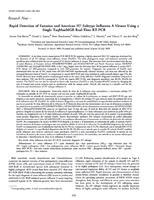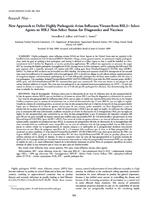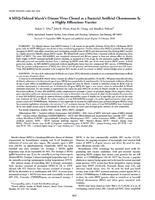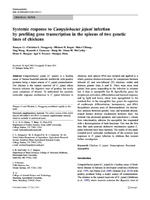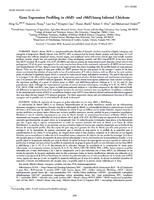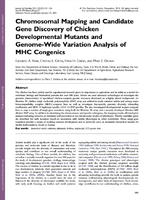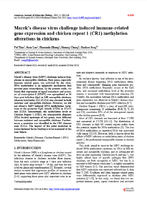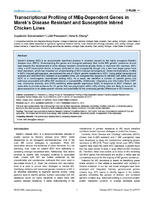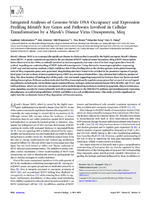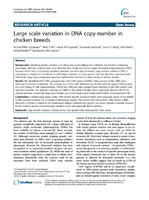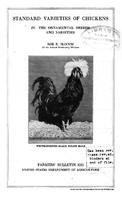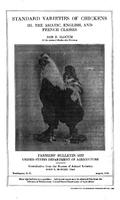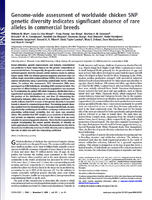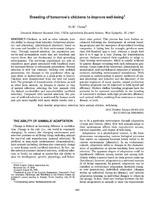Items from "Poultry Breeds": 40
Rapid Detection of Eurasian and American H7 Subtype Influenza A Viruses Using a Single TaqManMGB Real-Time RT-PCR
A real-time reverse transcription PCR (RRT-PCR) targeting a highly conserved HA2 H7 region was developed for the detection of all H7 subtype avian influenza viruses (PanH7). The wide phylogenetic scope and analytical sensitivity and specificity were validated with the use of a panel of 56 diverse influenza A viruses. The detection limit was…
Parvovirus-Associated Cerebellar Hypoplasia and Hydrocephalus in Day Old Broiler Chickens
Cerebellar hypoplasia and hydrocephalus were identified in day old broiler chickens showing nervous signs, impaired mobility, and diarrhea. At postmortem examination, brains of chickens were misshapen and cerebellums were smaller than normal. Microscopically, cerebellar folia were reduced in size and irregularly shaped, and the ventricles were…
New Approach to Delist Highly Pathogenic Avian Influenza Viruses from BSL3+ Select Agents to BSL2 Non-Select Status for Diagnostics and Vaccines
Highly pathogenic avian influenza viruses (AIVs) are Select Agents in the United States and are required to be handled in bio-containment level-3 enhanced (BSL3+) facilities. Using a reverse genetics system, we attenuated a highly pathogenic virus, with the goal of making it low pathogenic and having it delisted as a Select Agent so that it could…
A MEQ-Deleted Marek’s Disease Virus Cloned as a Bacterial Artificial Chromosome Is a Highly Efficacious Vaccine
The Marek’s disease virus (MDV) induces T-cell tumors in susceptible chickens. Of the 80 to 100 known MDV genes, only the MDV MEQ gene was shown to have transforming properties. Further evidence that MEQ is probably the principal oncogene in MDV came when researchers used overlapping cosmid clones of MDV and demonstrated that deleting MEQ…
Biologic Characterization of Chicken-Derived H6N2 Low Pathogenic Avian Influenza Viruses in Chickens and Ducks
Low pathogenic avian influenza H6N2 viruses were biologically characterized by infecting chickens and ducks in order to compare adaptation of these viruses in these species. We examined the clinical signs, virus shedding, and immune response to infection in 4-wk-old white leghorn chickens and in 2-wk-old Pekin ducks. Five H6N2 viruses isolated…
Systemic response to Campylobacter jejuni infection by profiling gene transcription in the spleens of two genetic lines of chickens
Campylobacter jejuni (C. jejuni) is a leading cause of human bacterial enteritis worldwide with poultry products being a major source of C. jejuni contamination. The chicken is the natural reservoir of C. jejuni where bacteria colonize the digestive tract of poultry, but rarely cause symptoms of disease. To understand the systemic molecular…
Gene expression profiling in rMd5- and rMd5Δmeq-infected chickens
Marek’s disease (MD) is a lymphoproliferative disorder of domestic chickens caused by a highly contagious and oncogenic α-herpesvirus, Marek’s disease virus (MDV). MD is characterized by bursal–thymic atrophy and rapid onset of T-cell lymphomas that infiltrate lymphoid tissues, visceral organs, and peripheral nerves with severe clinical signs that…
Chromosomal Mapping and Candidate Gene Discovery of Chicken Developmental Mutants and Genome-Wide Variation Analysis of MHC Congenics
The chicken has been widely used in experimental research given its importance to agriculture and its utility as a model for vertebrate biology and biomedical pursuits for over 100 years. Herein we used advanced technologies to investigate the genomic characteristics of specialized chicken congenic genetic resources developed on a highly inbred…
Analysis of global transcriptional responses of chicken following primary and secondary Eimeria acervulina infections
Characterization of host transcriptional responses during coccidia infections can provide new clues for the development of alternative disease control strategies against these complex protozoan pathogens. Methods: In the current study, we compared chicken duodenal transcriptome profiles following primary and secondary infections with Eimeria…
Marek’s disease virus challenge induced immune-related gene expression and chicken repeat 1 (CR1) methylation alterations in chickens
Marek’s disease virus (MDV) challenge induces lymphoma in susceptible chickens. Host genes, especially immune related genes, are activated by the virus. DNA methylation is an epigenetic mechanism that governs gene transcription. In the present study, we found that expression of signal transducer and activator of transcription 1 (STAT1) was…
Transcriptional Profiling of MEq-Dependent Genes in Marek’s Disease Resistant and Susceptible Inbred Chicken Lines
Marek’s disease (MD) is an economically significant disease in chickens caused by the highly oncogenic Marek’s disease virus (MDV). Understanding the genes and biological pathways that confer MD genetic resistance should lead towards the development of more disease resistant commercial poultry flocks or improved MD vaccines. MDV mEq, a bZIP…
Integrated Analyses of Genome-Wide DNA Occupancy and Expression Profiling Identify Key Genes and Pathways Involved in Cellular Transformation by a Marek’s Disease Virus Oncoprotein Meq
Marek’s disease (MD) is an economically significant disease in chickens that is caused by the highly oncogenic Marek’s disease virus (MDV). A major unanswered question is the mechanism of MDV-induced tumor formation. Meq, a bZIP transcription factor discovered in the 1990s, is critically involved in viral oncogenicity, but only a few of its host…
Large scale variation in DNA copy number in chicken breeds
Detecting genetic variation is a critical step in elucidating the molecular mechanisms underlying phenotypic diversity. Until recently, such detection has mostly focused on single nucleotide polymorphisms (SNPs) because of the ease in screening complete genomes. Another type of variant, copy number variation (CNV), is emerging as a…
Standard Varieties of Chickens: V. The Bantam Breeds and Varieties
Bantam chickens have a strong appeal to grown people and to children alike. Interest in them is widespread. They are bred extensively for exhibition and are kept also as pets and as utility fowl. The standard breeds and varieties of bantams include such a wide range of shape, color, and other characteristics that any individual taste can be suited…
Standard Varieties of Chickens: IV. The Ornamental Breeds and Varieties
The ornamental breeds and varieties of chickens often have an unusual appeal, and a breeder who may be first attracted to such fowls by their unusual plumage or form may later develop a flock which has decided utility value. Thus the keeping of ornamental breeds and varieties of chickens contributes to pleasure and the possibility of ample reward…
Standard Varieties of Chickens: III. The Asiatic, English, and French Classes
THE BREEDS of chickens included in the Asiatic, English, and French classes are in the main of a relatively large size, and have been developed primarily as meat breeds. They are not so commonly kept in this country as either the general-purpose or the egg breeds. The best-known meat breeds in the United States are those of the Asiatic class.…
Standard Varieties of Chickens: II. The Mediterranean and Continental Classes
IMPORTANCE OF EGG PRODUCTION.
EGG production doubtless is the leading branch of poultry keeping, and, in addition, is a very important agricultural activity. According to the last census the eggs produced in the United States in 1909 numbered more than 1,591,000,000 dozens, with a value of more than $306,000,000. Eggs, of course, are produced…
EGG production doubtless is the leading branch of poultry keeping, and, in addition, is a very important agricultural activity. According to the last census the eggs produced in the United States in 1909 numbered more than 1,591,000,000 dozens, with a value of more than $306,000,000. Eggs, of course, are produced…
Standard Varieties of Chickens: I. The American Class
The American class includes the Plymouth Rock, Wyandotte, Java, Dominique, Rhode Island Red, and Buckeye.
The fowls of these breeds are commonly called general- purpose fowls, because they are not only good egg producers but their carcasses are also well suited for the table. They are therefore the breeds best suited for the general farm flock,…
The fowls of these breeds are commonly called general- purpose fowls, because they are not only good egg producers but their carcasses are also well suited for the table. They are therefore the breeds best suited for the general farm flock,…
Genome-wide assessment of worldwide chicken SNP genetic diversity indicates significant absence of rare alleles in commercial breeds
Breed utilization, genetic improvement, and industry consolidation are predicted to have major impacts on the genetic composition of commercial chickens. Consequently, the question arises as to whether sufficient genetic diversity remains within industry stocks to address future needs. With the chicken genome sequence and more than 2.8 million…
Breeding of tomorrow’s chickens to improve well-being
Chickens, as well as other animals, have the ability to change their behavior (behavioral plasticity) and physiology (physiological plasticity) based on the costs and benefits to fit their environment (adaptation). Through natural selection, the population preserves and accumulates traits that are beneficial and rejects those that are detrimental…
 An official website of the United States government.
An official website of the United States government.


